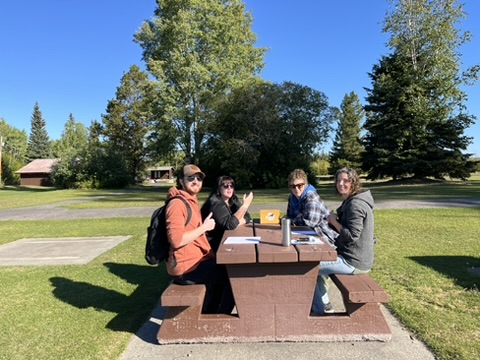
During a recent field trip to West Lake Provincial Park, our class engaged in a profoundly enriching learning experience that underscored the power of land-based education. By immersing ourselves in the natural world, we found new ways to connect teaching and learning to the environment, our lives, and the larger community, thereby highlighting the importance of land-based education.
Our day began with a focus on land acknowledgment, an essential practice in land-based learning that recognizes the histories, cultures, and ongoing contributions of Indigenous peoples whose traditional territory you reside. Working in small groups, we used a pamphlet prepared by our peers to guide us in crafting personalized acknowledgments. These were heartfelt expressions of our relationship with the land, acknowledging the Lheidli T’enneh First Nation, on whose unceded territory West Lake and Prince George reside.

Land-based learning embraces the idea that the land itself is a teacher. To embody this principle, we engaged in activities inspired by Walking Curriculum created by Dr. Gillian Judson, which emphasizes the pedagogical power of movement and observation in natural spaces. In small groups, we chose one of the suggested walks. My group selected a “shapes walk,” during which we searched for geometric forms in the landscape.

The exercise transformed the land into a canvas for discovery. We noticed triangles in the angles of the posts that held the gathering structure together, circles in the ripples of water and clouds, and rectangles in the textures of fallen bark. These shapes connected us to cognitive tools like pattern recognition and abstraction, demonstrating how land-based learning fosters creativity and critical thinking.
Reflecting on this experience, we discussed the versatility of the activity and how it could be adapted for various lessons, such as art, math, or science. This adaptability empowers educators to use the land as a teaching tool. This approach is deeply rooted in Indigenous ways of knowing, which teach us to view the land as a living entity with wisdom to share. We are helping to shape the next generation of land stewards, so building a connection with land early on in the educational quest is essential.

As I think about incorporating land-based learning into my future teaching practice, I am inspired by how it fosters respect, curiosity, and collaboration. Whether through nature walks, sit spots, or hands-on exploration, these experiences give students a deeper understanding of their place in the world and their responsibility to care for it. Land-based learning combined with the Walking Curriculum invites us to step outside the classroom and into the world, encouraging us to look for connections, deepen our understanding, and nurture our sense of wonder.

As we continue to explore how to bring more land-based learning into our teaching practices, I’m excited to think about how this approach can be integrated into future lessons. By focusing on the heart of teaching—relationships, connection, and presence—we can create learning experiences that are not only meaningful but transformative for both educators and students alike.
Leave a Reply